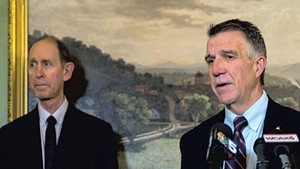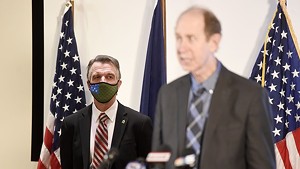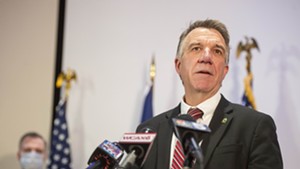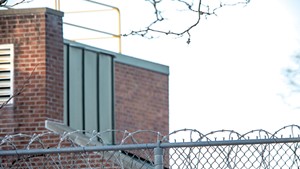
- Colin Flanders
- Health Commissioner Mark Levine (left) and Gov. Phil Scott
Updated 9:44 p.m.
Gov. Phil Scott on Friday evening declared a state of emergency in Vermont and issued a series of sweeping orders that will restrict some aspects of daily life in an effort to slow the spread of the coronavirus.
Scott’s orders include a ban on nonessential gatherings of more than 250 people and a restriction on access to long-term eldercare facilities. He’s also limiting out-of-state travel by state employees and said his administration will help those who can work remotely do so.
“The best information we currently have from the experts concludes that slowing it down and preventing as many cases as possible is the best way to make sure the most vulnerable, the very ill and the elderly get the care they need," Scott said during a press conference in Montpelier, flanked by nearly a dozen administration officials.
But he fell short of calling for the closure of Vermont schools, explaining that health officials believe that would not be an “effective” prevention method — “at least not yet,” he said.
“We believe keeping [kids] at schools rather than at home alone or with their parents and grandparents who are at risk is the best approach at this time,” he said. But he emphasized that he’s monitoring the situation daily, so parents should prepare for the possibility.
“We will not hesitate to act if the risks change,” he said.
The coronavirus originated in China in December and has since been declared a global pandemic, infecting more than 135,000 people. So far, Vermont officials have reported two cases, but Scott warned that “it’s just a matter of time before there are many more.”
“I’m fearful that, with our aging demographic, we may be more vulnerable than other states,” Scott said, “which is why I’ve put these measures in place.”
Health Commissioner Mark Levine, who also spoke at Friday’s press conference, said the governor’s orders will help “flatten the curve,” referring to a statistical chart that’s being used to visualize the rate of the spread of disease during epidemics. The approach relies on an understanding that while new cases are inevitable, prevention efforts may slow down the spread of the disease enough to allow health care systems to respond over time and not get overwhelmed.
"Our goals are quite straightforward," Levine said. "Protect the most vulnerable. Protect as many people as possible from getting infected, knowing that many still will, as this is truly a novel virus for the human race. And prevent the health care system from becoming overwhelmed, so we can deliver the best possible care to those in need and still retain a robust health care workforce."
Backing up Scott’s decision not to close schools, Levine explained that experts believe doing so too “early” does not have a great impact on slowing the spread of the disease.
“The advice is to time such closures slightly later in community spread but before that spike in the curve would occur,” he said. “A longer than two-week closure might be important at that time to be effective.”
Levine also shared an update of the state’s response to the crisis. He said prior to Friday, roughly 140 people had been tested over the course of 10 days. The state has ramped up efforts, he said.
“Based upon the experience of many other states and some of our adjoining states, we fully expect this number to increase,” Levine said of how many people have been tested.
The state is also monitoring "well over" 200 people, Levine said, a number he also expects will rise as state officials implement new Centers for Disease Control and Prevention recommendations and track down people who may have come into contact with Vermont’s latest patient.
That patient, a Chittenden County man in his seventies, was being treated at the University of Vermont Medical Center and remained in critical condition, officials said.
Amid reports of testing shortages nationwide, Levine sought to dispel any notion that Vermont is not testing enough people, stressing that the availability of tests is not preventing the state from testing those who meet criteria.
But he didn’t have an answer ready when asked whether he would be testing more people if he had a higher testing capacity. “We’re relying on the clinical judgment of our clinicians,” he said.
Scott jumped in a moment later to argue that wanton testing would “stress the system.”
“We have to, again, prioritize,” Scott said. “We don’t have an unlimited number of tests. If we did, maybe we would test more.”
Friday’s press conference was Scott’s first since Sunday. Since then, many Vermont colleges, including the University of Vermont, have opted to begin holding classes remotely due to the outbreak. Just hours before Scott declared the emergency, the state legislature voted to adjourn for at least 10 days.
“I know many are concerned and even scared,” Scott said. “I also know some will think this is not enough and others will think this is far too much. Please know every decision I make will be informed by the best science and the best experts we have available.”
He went on to ask people to “rise above frustrations and fear” instead of focusing on how the outbreak may “set us back.”
“What it’s really about is who we are as Vermonters and how we’re going to lead our state forward,” he said. “It’s not in our DNA to turn our backs on the most vulnerable. We’re going to face it. Fight it. And we’re going to win.”
















Comments (7)
Showing 1-7 of 7
Comments are closed.
From 2014-2020, Seven Days allowed readers to comment on all stories posted on our website. While we've appreciated the suggestions and insights, right now Seven Days is prioritizing our core mission — producing high-quality, responsible local journalism — over moderating online debates between readers.
To criticize, correct or praise our reporting, please send us a letter to the editor or send us a tip. We’ll check it out and report the results.
Online comments may return when we have better tech tools for managing them. Thanks for reading.